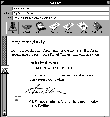



 |
OpenStep specification |
 |
OPENSTEP Enterprise product brochure |
 |
How to get started on NT today! |

In the beginning, NeXT made computers--trademark black hardware that sported a very slick graphical desktop. The NeXT computer was fun to use. It was easy to network and, relative to the competition, a dream to develop for. Its operating system, which came fully loaded with user applications and a development environment, was called NEXTSTEP.
NeXT introduced its "cube" in 1988. Over the next few years, the company added to its own hardware line and also ported NEXTSTEP to Intel, HP, and Sun boxes. Then to reach a broader market, the company stopped making its own hardware in 1992 and focused on selling NEXTSTEP for PCs and workstations. A developer's meccaThe NEXTSTEP UI was a big hit with users. But what many customers prized even more was the development environment. Frameworks of prebuilt objects provided developers with functionality that worked "out of the box"--so much of their work was done before they even began. While prebuilt objects dramatically slashed development time, a suite of graphical development tools made it easy to integrate the application with the customer's existing data. This was key for IT organizations who couldn't afford to scrap or modify costly database and mainframe programs. In addition, developers could reuse objects across other new applications, saving time in later development. And they could relocate and update objects on the fly--to scale across servers as the company grew, and to make time-critical changes fast, without going offline. With NEXTSTEP, corporations could finally afford to develop and scale custom applications fast enough to keep up with competition and change. NEXTSTEP becomes OPENSTEPNEXTSTEP initially ran on a version of the UNIX operating system called Mach. When it became clear that Mach was not the world's OS of choice, NeXT opened the way for its object-oriented development environment to exist on any platform. In 1994, NeXT published the OpenStep specification--an API (Application Programmer's Interface) for an object layer, based on NEXTSTEP frameworks, that could be implemented independent of underlying hardware, the operating system, and the user interface. This meant anyone could implement NeXT object frameworks and tools--to build what were now called OPENSTEP* applications--on any OS. * OpenStep was originally spelled with some lowercase letters. Later NeXT changed the spelling to all caps for its OPENSTEP product line. OPENSTEP integrates popular platforms and the InternetToday, NeXT, Sun, and Apple offer products for building and deploying OPENSTEP applications across Windows, Mach, the Internet (using WebObjects), Solaris, and soon Rhapsody. OPENSTEP applications have the look and feel of their native user environment. But underneath, they share the same objects. They integrate with the same corporate data. You can develop them once on one platform and redeploy easily across others. You can maintain several of them from one source. And they work seamlessly with applications around them--on Windows with other Windows applications, on Rhapsody with other Macintosh applications, on Solaris with Solaris and Java applications, and so on.
To find out more about OPENSTEP, check out the product brochure for OPENSTEP Enterprise. OpenStep Specification overviewThe OpenStep API includes frameworks of prebuilt objects, and a dynamic object runtime that makes applications easy to scale and customize. It includes:
For the full text of the specification, click here. Related Press Releases | ||||||||||





 Application framework with
GUI controls and support for event management
Application framework with
GUI controls and support for event management
